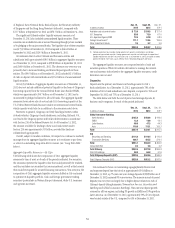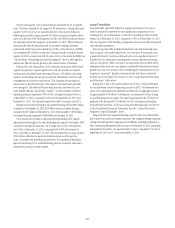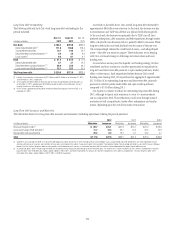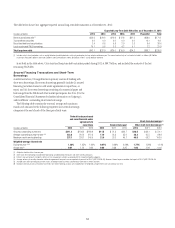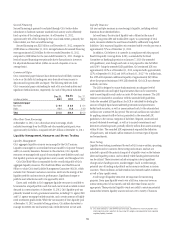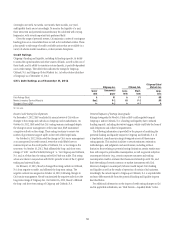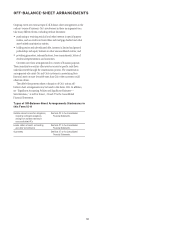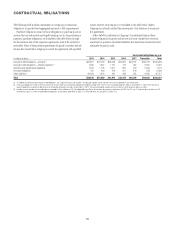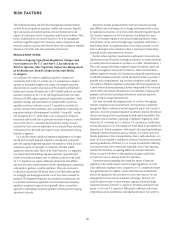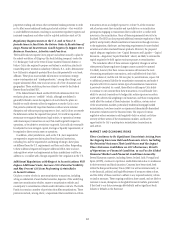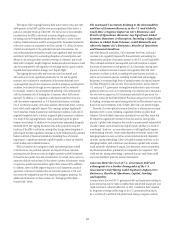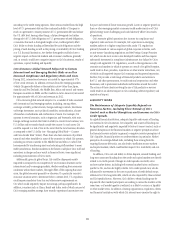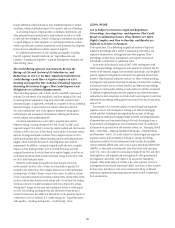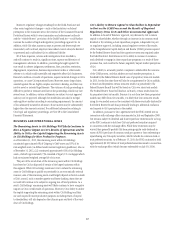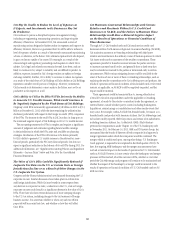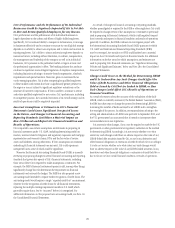Citibank 2012 Annual Report Download - page 82
Download and view the complete annual report
Please find page 82 of the 2012 Citibank annual report below. You can navigate through the pages in the report by either clicking on the pages listed below, or by using the keyword search tool below to find specific information within the annual report.60
RISK FACTORS
The following discussion sets forth what management currently believes
could be the most significant regulatory, market and economic, liquidity,
legal and business and operational risks and uncertainties that could
impact Citi’s businesses, results of operations and financial condition. Other
factors, including those not currently known to Citi or its management,
could also negatively impact Citi’s businesses, results of operations and
financial condition, and thus the below should not be considered a complete
discussion of all of the risks and uncertainties Citi may face.
REGULATORY RISKS
Citi Faces Ongoing Significant Regulatory Changes and
Uncertainties in the U.S. and Non-U.S. Jurisdictions in
Which It Operates That Negatively Impact the Management
of Its Businesses, Results of Operations and Ability
to Compete.
Citi continues to be subject to significant regulatory changes and
uncertainties both in the U.S. and the non-U.S. jurisdictions in which it
operates. As discussed throughout this section, the complete scope and
ultimate form of a number of provisions of The Dodd-Frank Wall Street
Reform and Consumer Protection Act of 2010 (Dodd-Frank Act) and other
regulatory initiatives in the U.S. are still being finalized and, even when
finalized, will likely require significant interpretation and guidance. These
regulatory changes and uncertainties are compounded by numerous
regulatory initiatives underway in non-U.S. jurisdictions in which Citi
operates. Certain of these initiatives, such as prohibitions or restrictions on
proprietary trading or the requirement to establish “living wills,” overlap
with changes in the U.S., while others, such as proposals for financial
transaction and/or bank taxes in particular countries or regions, currently
do not. Even when U.S. and international initiatives overlap, in many
instances they have not been undertaken on a coordinated basis and areas
of divergence have developed with respect to scope, interpretation, timing,
structure or approach.
Citi could be subject to additional regulatory requirements or changes
beyond those currently proposed, adopted or contemplated, particularly
given the ongoing heightened regulatory environment in which financial
institutions operate. For example, in connection with their orderly
liquidation authority under Title II of the Dodd-Frank Act, U.S. regulators
may require that bank holding companies maintain a prescribed level
of debt at the holding company level. In addition, under the Dodd-Frank
Act, U.S. regulators may require additional collateral for inter-affiliate
derivative and other credit transactions which, depending upon rulemaking
and regulatory guidance, could be significant. There also continues to
be discussion of potential GSE reform which would likely affect markets
for mortgages and mortgage securities in ways that cannot currently be
predicted. The heightened regulatory environment has resulted not only
in a tendency toward more regulation, but toward the most prescriptive
regulation as regulatory agencies have generally taken a conservative
approach to rulemaking, interpretive guidance and their general ongoing
supervisory authority.
Regulatory changes and uncertainties make Citi’s business planning
more difficult and could require Citi to change its business models or even
its organizational structure, all of which could ultimately negatively impact
Citi’s results of operations as well as realization of its deferred tax assets
(DTAs). For example, regulators have proposed applying limits to certain
concentrations of risk, such as through single counterparty credit limits or
legal lending limits, and implementation of such limits currently or in the
future could require Citi to restructure client or counterparty relationships
and could result in the potential loss of clients.
Further, certain regulatory requirements could require Citi to create new
subsidiaries instead of branches in foreign jurisdictions, or create subsidiaries
to conduct particular businesses or operations (so-called “subsidiarization”).
This could, among other things, negatively impact Citi’s global capital and
liquidity management and overall cost structure. Unless and until there is
sufficient regulatory certainty, Citi’s business planning and proposed pricing
for affected businesses necessarily include assumptions based on possible or
proposed rules or requirements, and incorrect assumptions could impede
Citi’s ability to effectively implement and comply with final requirements in
a timely manner. Business planning is further complicated by the continual
need to review and evaluate the impact on Citi’s businesses of ongoing rule
proposals and final rules and interpretations from numerous regulatory
bodies, all within compressed timeframes.
Citi’s costs associated with implementation of, as well as the ongoing,
extensive compliance costs associated with, new regulations or regulatory
changes will likely be substantial and will negatively impact Citi’s results of
operations. Given the continued regulatory uncertainty, however, the ultimate
amount and timing of such impact going forward cannot be predicted. Also,
compliance with inconsistent, conflicting or duplicative regulations, either
within the U.S. or between the U.S. and non-U.S. jurisdictions, could further
increase the impact on Citi. For example, the Dodd-Frank Act provided for the
elimination of “federal preemption” with respect to the operating subsidiaries
of federally chartered institutions such as Citibank, N.A., which allows for a
broader application of state consumer finance laws to such subsidiaries. As a
result, Citi is now required to conform the consumer businesses conducted by
operating subsidiaries of Citibank, N.A. to a variety of potentially conflicting
or inconsistent state laws not previously applicable, such as laws imposing
customer fee restrictions or requiring additional consumer disclosures.
Failure to comply with these or other regulatory changes could further
increase Citi’s costs or otherwise harm Citi’s reputation.
Uncertainty persists regarding the competitive impact of these new
regulations. Citi could be subject to more stringent regulations, or could
incur additional compliance costs, compared to its U.S. competitors because
of its global footprint. In addition, certain other financial intermediaries
may not be regulated on the same basis or to the same extent as Citi and
consequently may have certain competitive advantages. Moreover, Citi
could be subject to more, or more stringent, regulations than its foreign
competitors because of several U.S. regulatory initiatives, particularly with
respect to Citi’s non-U.S. operations. Differences in substance and severity
of regulations across jurisdictions could significantly reduce Citi’s ability to



